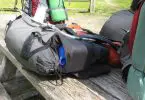Whether you’re looking to buy a jacket, sleeping bag, or another type of insulation, you’re likely to be met with a wide range of options that you need to choose between. One of these is what type of insulation you would like to get.
Two of the most popular options are down and PrimaLoft, but which of these is the best option?
While down is a great choice for insulation, its lack of water resistance, price, and ethical issues means PrimaLoft is the better choice for insulation. This is despite down having a greater fill power and ability to bounce back after repeated compressions.
Throughout this article, we have used described using down/PrimaLoft in jackets and sleeping bags interchangeably. The attributes of the insulating materials are the same between these and many products to provide insulation.
Let’s have a look at this in a bit more detail to understand how we’ve come to that conclusion.
Introducing the competitors?
Before we get into the detail of what areas down and PrimaLoft are better than the other with, let’s first get familiar with what down and PrimaLoft actually are.
What is Down?
Down is made from a particular type of feathers that come from ducks, geese, and other water birds. However, not all of a duck’s/goose’s feathers are suitable for being used for insulation. Each of these birds has a layer of delicate feathers that provides them with an undercoat under the feathers we are more likely to think about.
This undercoat helps to keep them warm by trapping air in the plumage, which is what makes it such a great choice for keeping us warm.

Duck or Goose Down For Insulation?
When someone is looking at buying something with down insulation, they tend to be looking for the warmth and comfort that it provides. Down from geese will tend to have a better warmth-to-weight ratio than down from ducks.
However, the quality of the down is also important. A higher-quality duck down will provide the wearer with better insulation than a jacket made from a lower-quality goose down.
Goose down also has the added benefit of being able to be packed down smaller than duck down. This means that you can pack more goose down into the same area, giving you greater warmth in the same space, or you can compress it down to a smaller space. This is great if you’re on a hiking trip as you’re able to pack your jacket away in a much smaller space.
Recommended Reading: We’ve written a whole article on the difference between duck and goose down that you might be interested in.
How Is The Of Down Quality Measured?
As mentioned earlier, the quality of the down that is being used in jackets is important. A jacket with higher quality duck down can outperform a jacket with lower quality goose down.
‘Fill power’ is the way in which the quality of a down is rated and measured. The higher the fill power number, the higher quality the down is considered but as a rough guide:
- Anything over 650 fill power is considered to be a high-quality down
- 750-850 fill power is very high quality
- 900 fill power and above is the highest quality you’re able to get.
The way that fill power is determined is by measuring the number of cubic inches that one ounce of down takes up in an appropriate climate-controlled test cylinder. The greater the volume, the better the warmth-to-weight ratio the down has and, therefore, the higher rating it receives.
We would recommend that if your budget allows that you should look for insulation with at least a rating of 550 fill power, though higher than that would be preferable.
What is down-to-feather ratio?
As down is expensive to it commonly has normal feathers mixed in to help bulk the insulation up. As the name suggests, this gives us the down-to-feather ratio. The down-to-feather ratio is normally presented like 90/10, which means that the insulation is made up of 90% down and 10% feather.
As you would expect, the higher the percentage of down in the insulation, the warmer it will be. So it is recommended that you look for down that is as close to 100% down as you can reasonably afford.
What is PrimaLoft?
PrimaLoft is currently considered by many to be the leading brand for synthetic insulation. It isn’t the only synthetic insulation brand that is available but is definitely the most popular.
The insulation originates from a patented synthetic insulation material that was developed in a joint venture between the US Army and the Albany International Corporation in the 1980s. The US Army was interested in having a synthetic insulation that was as good as goose down but continued to retain warmth while wet. From that work, PrimaLoft was created.
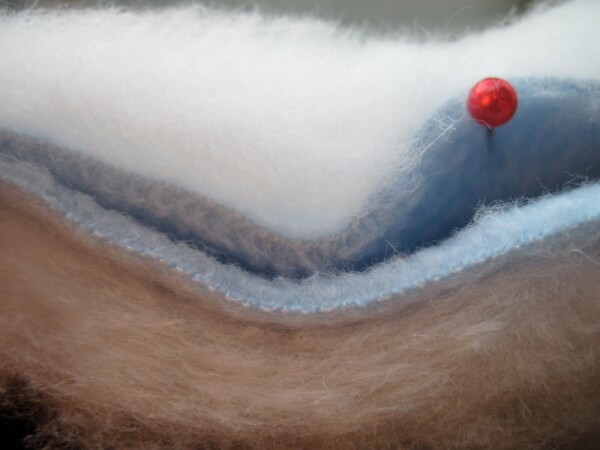
How Well Does PrimaLoft Perform When Wet?
The biggest advantage of PrimaLoft is that it continues to provide insulation even when wet, which is where down struggles, but how well does it continue to perform?
Wet PrimaLoft continues to provide 96% of the insulating capability compared to when it is dry. This makes it ideal for use in jackets, sleeping bags, and footwear that may get wet during use.
Being able to continue to provide 96% of the insulating capability is a great achievement. Obviously, it is far better if you can avoid getting wet in the first case, whether that’s through the use of waterproofs or just finding shelter during rain, but sometimes that’s not possible.
Is PrimaLoft Biodegradable?
Over the last few years, the world has started to wake up to the problems that synthetic materials can pose to the environment. As nature lovers, a lot of PrimaLoft’s customers are keen to do what they can to help the planet, which is why many are keen to know whether PrimaLoft is biodegradable or not?
Not all PrimaLoft insulations are biodegradable. PrimaLoft released a synthetic insulation that was made from biodegradable fibers in 2018. However, the majority of the PrimaLoft lineup is not currently biodegradable.
The move towards producing biodegradable versions of their insulation is great news for the environment. It means that PrimaLoft insulation will break down far faster if it ends up in a landfill instead of being recycled.
PrimaLoft also does a number of products that are made from 100% recycled materials, which is another great push forward from the company.
Attributes
Now that we are familiar with both down and PrimaLoft let’s look at how each of them performs in different categories that we feel are important when looking for insulation.

Warmth: Down
Out of the two options, down is by far the superior option when looking at warmth. It’s far warmer per ounce than any synthetic material we currently have. This means to achieve the level of insulation, more PrimaLoft is required, which increases the weight.
Down is also very compactable; this means that it is also more compressible on top of providing more insulation for the same volume. Meaning that more of it can be put into the same jacket or sleeping bag, making them even better insulated.
Breathability: PrimaLoft
A breathable material helps to regulate how much moisture is retained between the fabric and your body.
Both PrimaLot and Down are very breathable insulations. However, PrimaLoft is a better choice as you don’t have to worry about absorbing moisture. Additionally, products that use PrimaLoft insulation can use a lighter weight face fabric as it doesn’t need to prevent the down from escaping.
While both down is a great choice for breathability, we’ve gone with PrimaLoft for this category. This is due to how down absorbs moisture, which will include sweat. If that sweat is absorbed into the material, it makes the down the perfect breeding place for mold, which will start to decrease the life of your jacket.
The outer fabric, commonly known as the ‘face fabric,’ in down jackets, has a tight weave to help prevent the down from leaking out of the jacket; this will decrease the breathability of the jacket by a minimal amount. However, jackets that use PrimaLoft, or other synthetic insulation, do not need to prevent the down from starting to poke out, so they can have a looser weave.
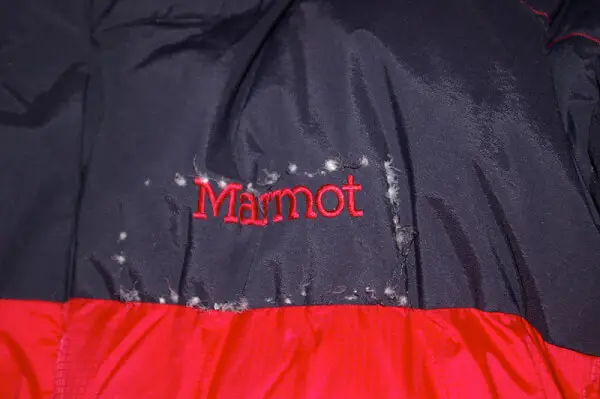
Water-resistance: PrimaLoft
We won’t stay long on this section as it has been covered throughout this article.
For all the benefits of down, its biggest drawback is that it does not handle getting wet very well. When down gets wet is causes the feathers inside to clump together, drastically reducing their ability to provide insulation. Worse than that, as the down dries, if it is not broken up, then the down can continue to stay in the clumped up state.
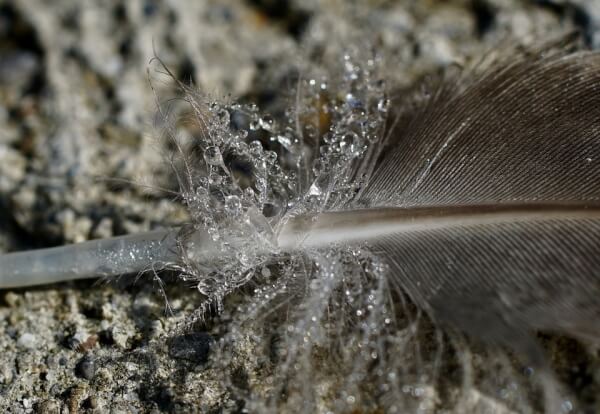
It is getting more common to find products that are insulated with down that have been treated with chemicals to make them more resistant to water. This type of down is commonly called hydrophobic down. However, even with the chemical treatment, it is best to minimize the contact between the down and water. It will still not provide the full insulation that it could when dry, and it will slowly deteriorate the chemical treatment.
Another method that is used to help reduce the issue of down’s inability to handle water is through the use of more water-resistant materials for the face fabrics. Again, this helps, but I still wouldn’t recommend counting on it when deciding what to wear in a downpour.
Maintenance: PrimaLoft
With proper care and maintenance both down and PrimaLoft will last considerably longer.
Washing down is more awkward than washing PrimaLoft; this is due to how down will start to clump together when it gets wet. It is also necessary to ensure that the clumps of down are properly broken up as the down dries to avoid it from drying in clumps.
Recommended Reading: We’ve written a whole article on how to wash down sleeping bags without damaging them that you might be interested in.
Below is an example of what you can expect with washed down that hasn’t had the clumps broken up. It’s important to remember when you’re trying to try down that while the face fabric may feel dry, the actual down can still be wet and clumping.
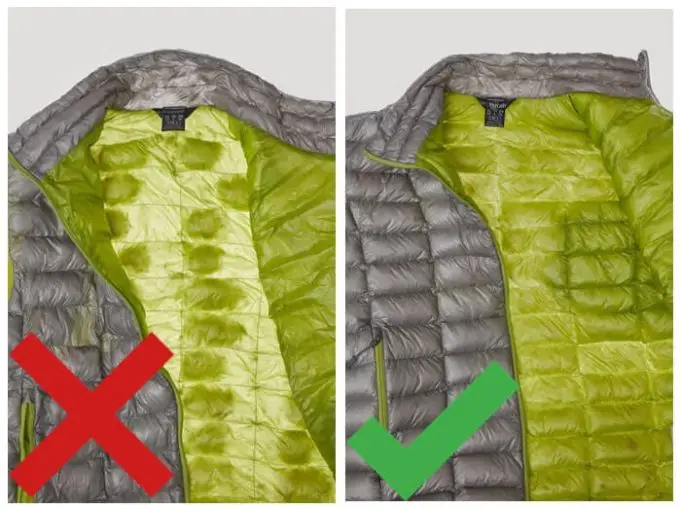
PrimaLoft’s water-resistant nature makes it far easier to clean. The synthetic materials don’t clump up and don’t require any help while it is drying.
PrimaLoft tends to be machine washable in cold water. A lot of products that use PrimaLoft are also able to be dried on a gentle setting. Some are also able to be dry cleaned, but the manufacturers tend to recommend against the use of harsh chemicals being used as part of the cleaning.
Compressibility: Down
When bringing insulation with you, it can start to take up a large amount of space, which when you’re on a multi-day hike will use up space that could be used for other essentials. This is why the amount that the insulation can compress is important.
Down is able to compress down far better than PrimaLoft can, making it the better choice when it comes to compressibility. PrimaLoft also loses its ability to bounce back from being compressed over time.

Down also has the added advantage in that it is more insulating than PrimaLoft. This helps because it means you don’t need quite as much to achieve the same level of insulation as if you had gone for the same product using PrimaLoft.
An additional factor to take into consideration for compressibility is that as PrimaLoft is a synthetic material, it cannot compress as many times as down can before it starts to lose its ability to bounce back. While it can still be compressed down a significant number of times, this is a limitation that should be considered.
Price: PrimaLoft
While we all know that products that are designed for hiking tend to be expensive, it is still something that we need to consider when we are looking at buying gear.
As down comes from animals, there are more steps and contributors to the overall price. The price of the down needs to take into account the raising, caring, and plucking of the birds, transportation, and any chemical treatments that are applied to make them waterproof.
The fabrics that are used in down jackets and sleeping bags tend to be of higher quality. This is partially to help keep the down inside but also because if someone is paying a higher price for the insulation, they are likely to want higher-quality fabrics as well.
PrimaLoft has fewer contributors to the price as it can be made quickly without long raising times. This allows for more to be spent on the fabrics compared to a similarly priced down product.
Weight: Down
When we are out on a hike, every pound that we are carrying increases the exertion that we go through on the hike, and the more food we need to either carry with us or find to fuel us on the hike. For this reason, it is good to be able to keep the weight to a minimum, but which of our contenders is able to provide the best warmth to weight ratio?
Down is able to be lighter than PrimaLoft while providing the same level of insulation. This is due to down being able to create more air pockets that retain the heat from a smaller volume of material.
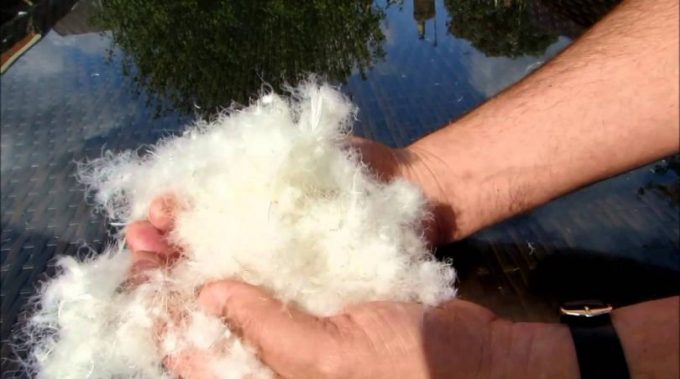
As down has a far greater fill power than PrimaLoft, it is able to provide the same amount of insulation from less weight.
To avoid down from poking through the face fabric, heavier duty fabrics with tighter weaves tend to be used for down products. This will contribute to the overall weight of the product.
PrimaLoft, on the other hand, requires additional material to provide the same amount of insulation but doesn’t require a tight weave fabric.
Longevity: Down
When you’re spending a considerable amount of money on a high-quality product, you’re going to want it to last longer to make the cost per use lower.
When properly cared for, down will outlive a product made with PrimaLoft. The use of higher quality face fabric and its ability to bounce back from compression will allow a down product to last longer. However, it is more likely to suffer from mold and dust mites, which will reduce its lifespan.
Over time down jackets will build up mold and dust mites. These can start to shorten the lifespan of the insulation as well as increase the likelihood of the wearer suffering from allergic reactions or inflammation of asthma.
Another problem faced by down is that the face fabric will start to allow down to start to poke through after a time. This results in not only visible signs of the down trying to escape but also small points that can irritate your skin and cause general discomfort.
As discussed previously, down is far better at retaining its ability to bounce back from compression. This means that over a number of years, while down will retain its insulation and volume, PrimaLoft will start to stay more compressed, drastically reducing its ability to trap air for insulation.
For both down and PrimaLoft, their lifetime will be vastly increased through proper care and maintenance.
Other Factors
While those are the attributes for the insulation and how they compare, these are not the only considerations that need to be taken into account when you’re choosing what type of insulation you should be looking at.
Ethical Sourcing: PrimaLoft
As covered above, down comes from goose/duck feathers. Unfortunately, for most down, the birds are normally killed to allow for the plumage to be collected.
In addition to the killing of the birds for their plumage, many are concerned about the condition that the birds are raised and kept. This will be the same with any form of industrial-scale raising of animals for use by humans.
If you would like to get something with down insulation but you’re also keen on ethical sourcing then it may be worth looking at eiderdown. This is because it is collected from what the duck leaves behind rather than taking the down directly from the ducks. This does make it more expensive than duck or goose down, as the supply is far more limited but doing the right thing tends to cost more.
You can also look into manufacturers that adhere to “The Down Codex,” which requires that down is only sourced from ducks and geese that are being used in the meat industry. While this doesn’t completely remove the ethical questions, it does mean that the animal hasn’t just been killed for the purpose of insulation.
Obviously, as PrimaLoft is a synthetic insulation you do not have the same ethical sourcing issues.
Allergies: PrimaLoft
While it is not unheard of for people to have allergic reactions to synthetic materials, it is far more common for people to have allergic reactions to natural materials, and down is no different.
The allergic reactions to down are more likely as the down starts to get older and from the growth of mold. Down is also a perfect breeding ground for dust mites. Both of these can lead to allergies or inflammation of asthma. This is more common with down pillows and other bedding items but can still happen with jackets.
One extreme example is a man who suffered from “malaise, fatigue and breathlessness”, which was eventually traced back to a new feather duvet that he had purchased. You can read more about this case on health.com.
This is not an issue for PrimaLoft, which is hypoallergenic. PrimaLoft is also specifically designed to prevent the growth of mold, helping it to last longer without issues for the wearer.
Summing Up
So after our in depth review of the attributes for each of these types of insulation, how have our competitors faired?
- Warmth: Down
- Breathability: PrimaLoft
- Water-resistance: PrimaLoft
- Maintenance: PrimaLoft
- Compressibility: Down
- Price: PrimaLoft
- Weight: Down
- Longevity: Down
- Ethical Sourcing: PrimaLoft
- Allergies: PrimaLoft
We’ve found that PrimaLoft is the winner in 6 out of the 10 attributes we have looked at in this article, while down was only the winner in 4.
Based on your preferences, you may decide that some attributes are more important to you than others, which will make a difference to what is the better choice for you. Our aim in this article is to provide you with all the information you need to be able to make your own decision based on these preferences.




